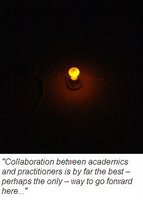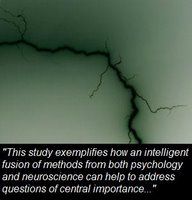 By Dryden Badenoch, of The Relaxed Therapist
By Dryden Badenoch, of The Relaxed Therapist.
Medical outcome research tends to focus upon finding the best drug to treat a given disease. The patient's role is often no more than the repository of the disease and the recipient of the drug: their personal characteristics are rarely considered, except where these support the diagnosis (e.g. Type A personality in cardiac care) or impede treatment (e.g. non-adherence to medication).Psychological outcome research tends to follow the same model, matching therapy to diagnosis. The client is again little more than the holder of the diagnosis and the subject of the therapy: their individual decisions and personality are rarely considered (again, except where these are part of the diagnosis or lead to non-compliance).Contrary to notions of the 'miracle therapy' or 'super-shrink', recent research suggests that the client contributes as much to the chances of a successful outcome in therapy as either the therapist or their technique. In fact, client factors may predict more of the outcome than therapeutic rapport and technique combined.Anne Hook and Bernice Andrews (2005) surveyed people who had received psychological therapy for depression. Half of the current clients and a third of ex-clients reported withholding some information about their depressive symptoms (e.g. low self worth, suicidal thoughts) and behaviour (e.g. substance abuse, aggression) from their therapist.The main reason given for withholding information was shame. People who had concealed symptoms were more depressed on completion of therapy than those who had 'revealed all'.As their previous research had linked a tendency to feel shame to higher levels of depression, this seems a fairly obvious result: shame and related non-disclosure are simply part of the clinical picture of depression.After accounting for variables such as age, gender, education, time spent in therapy, time since therapy and worst ever level of depression, they found that the decision to withhold information predicted 8 per cent of the variation in current level of depression, overriding the effect of any tendency to feel shame. Again, this seems obvious: therapists can't treat symptoms they don't know about.Taken together, however, the message is that, while a client's traits may influence both their presentation and recovery, the outcome of therapy is strongly influenced by decisions the client makes without the awareness of the therapist. These will in turn be influenced by events in and out therapy (e.g. the approachability of the therapist, discussions with friends, etc.).This result has implications at three levels: first, by identifying shame as underlying most non-disclosure in therapy, Hook and Andrews have given a lead to therapists seeking to engage their clients: creating a non-judgemental environment and highlighting and addressing issues of shame can promote a better outcome.Second, by illustrating the effect of individual client decisions on therapeutic outcome, Hook and Andrews have furthered the argument for routinely considering the client's contribution to the effectiveness of psychological therapies, rather than treating the client as a passive recipient of the 'miracle therapy' or the attentions of the 'super-shrink'.Finally, by linking shame and non-disclosure of symptoms, Hook and Andrews have raised doubts about the model of medical treatment studies. Is it likely that patients with physical symptoms are unashamed and disclose them fully to their doctor? Perhaps there is as much of a role for explicit consideration of client factors in medical outcome studies as in studies of psychological therapies?Following Hook and Andrews' findings, I decided a website for like-minded therapists would be one way I could support the move towards engaging with clients not as diagnoses or even sets of traits, but as individuals interacting uniquely with us.__________________________________Hook, A. & Andrews, B. (2005). The relationship of non-disclosure in therapy to shame and depression. British Journal of Clinical Psychology, 44, 425-438.
Dryden Badenoch is an NHS Consultant Clinical Psychologist.
You have read this article Anniversary /
Mental health
with the title Anniversary. You can bookmark this page URL http://psychiatryfun.blogspot.com/2006/10/nice-therapist-shame-about-symptoms.html. Thanks!
 To mark three years since the birth of the British Psychological Society’s Research Digest as a free email newsletter, I’ve asked some of the world’s best psychology bloggers to discuss a psychology journal article from the last three years which they found inspiring or that changed the way they think. Here’s what they chose:
To mark three years since the birth of the British Psychological Society’s Research Digest as a free email newsletter, I’ve asked some of the world’s best psychology bloggers to discuss a psychology journal article from the last three years which they found inspiring or that changed the way they think. Here’s what they chose:










